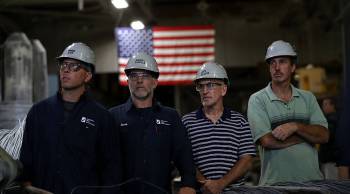
Is retraining worth it? Laid off paper millworkers weigh the benefits
Is retraining worth it? Laid off paper millworkers weigh the benefits

The idea of more open, global trade has been sold as necessary for economic success. Yet today we hear calls to “build a wall” and to break up trading partnerships. Turns out we’ve seen the pendulum swing between free trade and protectionism many times before. Our series Trade Off looks at key moments when trade barriers have been built up or torn down and at globalization’s winners and losers.
In Wisconsin, a state Donald Trump won in November, over 90,000 factory workers have lost jobs since 2000. That includes employees in more remote parts of the state, where legacy industries like paper have employed generations of families.
The U.S. government has a variety of programs to help workers who’ve lost jobs to globalization. The idea is with a little government help, Americans can find other well-paid jobs in the industries of the future. But in reality, reinvention is really hard.
In 1892, Mark Van Stappen’s grandfather started work in a new paper mill in Kimberly, Wisconsin. The Kimberly-Clark Corp. built the mill and the town. Seven of Van Stappen’s uncles worked at either that mill or others along the Fox River in northeastern Wisconsin. In 1979, he followed in their footsteps.
“I started at the bottom, some horrendously hard-working jobs where you threw logs all day into grinders,” Van Stappen recalled. “But it was kind cool. It was all right. It was sort of therapeutic.”

Former paper mill worker Mark Van Stappen tells Marketplace he worked at the mill in Kimberly, Wisconsin, for almost three decades. His grandfather started working at the same mill in 1892.
When the plant closed in 2008, Van Stappen and other workers stripped off a big chunk of paper from the last batch the mill produced and scribbled messages to NewPage, the mill’s owner at the time. People wrote messages like “Sell us to someone who cares,” “Make paper again,” “Keep us as a community” and “Keep Jobs in America.”
A decade later, Van Stappen still keeps that long scroll of paper in his basement, and the high school football team in Kimberly is still the Papermakers. But since 2000, 19 paper mills in the state have closed. Between 2005 and 2015 alone, Wisconsin lost over a third of its paper mill jobs.
Paper companies here are battling two powerful economic disruptions: cheap imports from places like China and Brazil, and the digital revolution. The more e-readers and the like, the less demand for paper for magazines and books, the kind of high-quality paper Wisconsin mills were known for. For Van Stappen, those big global forces hit home in a very personal way.
“My wife was working part time when I worked at the mill,” Van Stappen said. “And immediately she says ‘I have to go work full time. I have to. We no longer have stability in our lives, y’know?’”
In 2008, workers at the paper mill in Kimberly protest the mill’s closing. They signed a long scroll of paper from the mill, urging owners to keep it open.
Van Stappen’s wife took a job at a company making envelopes, and he fell a couple rungs down the economic ladder. He’d been making $22 an hour with great health insurance, a 401(k) and six weeks vacation. His co-workers, many of whom he’d known since high school, were like his second family. That all ended.
Van Stappen took a job at a small green-energy startup at a couple dollars an hour less, lesser health insurance and a longer commute. His former co-worker Andy Nirschl thought about going back to school to retrain for another career, but rejected the idea.
“I looked a little bit into training, but I didn’t especially care for school when I was in it in high school, so I wasn’t lookin’ at going back again,” Nirschl said. “I tried a couple different paper mill jobs, but I didn’t get hired at any.”
After eight months, Nirschl finally landed a job as a case manager for laid-off workers like himself. It paid him about $8 an hour less, came with fewer benefits, and his wife, like Van Stappen’s, had to find a full-time job.

The tiny downtown of Nekoosa, Wisconsin, still has a running paper mill. The community has been making paper along the Wisconsin River since the 19th century.
In Wood County, 100 miles to the west of Kimberly, the Wisconsin River winds through lush hardwood forests and cranberry bogs. It was once called the “hardest working river in America” for all the paper mills and power plants on its banks. In 2008, a century-old mill in Port Edwards closed and over 500 people lost their jobs. Rene Daniels, executive director of the North Central Wisconsin Workforce Development Board, said they were good jobs, paying an average $55,000 a year.
“This was a population which had really, really high incomes for this community,” Daniels said. “And we knew going in that it would be highly unlikely to replace those wages.”
With enough overtime, some mill workers were earning six figures. In rural Wisconsin, where a modest home can sell for well below that, a mill job was a ticket to a solid, middle-class life.
A 2014 survey of those 500 Port Edwards workers wasn’t all bad news. Most of them found new jobs. On average, they paid less, but only by about 9 percent, a surprisingly good outcome given the workers’ rural location. But around 22 percent of the laid-off workers did not find new jobs or retired early.
| Why do U.S. retraining programs fall short? |
| The place where globalization kept its promise |
Less than half chose to retrain for a new career.
What surveys like that don’t measure, of course, are the confusion and self-doubt many veteran workers experience. Connie Tomski-Faville used to teach Microsoft Office to dislocated mill workers who went back to school.
“So they have this computer sitting in front of them,” Tomski-Faville said. “They think they’re going to break it. They’re convinced that it’s going to blow up or start on fire or something, so we usually have to break through that barrier first.”
“Retraining” can mean a couple years of vocational school, an apprenticeship, even remedial education. But the support varies, depending on the program. Right now, if the government decides you’ve lost your job to free trade, you qualify for a more generous package of benefits called Trade Adjustment Assistance. It’s a distinction that no longer makes much sense, given the close link between globalization and automation.
Jeff Pearl, an engineer, lost his job at a paper company in Wisconsin Rapids in a 2000 downsizing. Since then, he’s started his own engineering firm across the Wisconsin river from his old employer.
Pearl recalls a former mill worker who’d retrained at the local technical college and then applied for a draftman’s position at his firm.
“And unfortunately, they only start at about $15 an hour here,” Pearl said. “And he was just quite appalled, like, I can’t afford to live like that. I felt bad having to break this news to the gentleman that even though he might have 30 years machine experience, he doesn’t have any experience as a draftsperson to come to work for us.”

Jeff Pearl and Charles Schmalz of Pearl Engineering in Wisconsin Rapids say paper mills in the state have been hurt by cheap Chinese imports and the digital revolution.
Retraining doesn’t always pay off as handsomely as people hope. And sometimes it steers people into the wrong jobs. Workers aren’t like pegs you can simply punch into holes where there’s market demand. Jim Golembeski, executive director of the Bay Area Workforce Development Board, based in Green Bay, administers federal job training programs in 11 counties in northeastern Wisconsin. He says health care, for example, is a growth industry, but that doesn’t mean it’s fit for most laid-off factory workers.
“Not everybody wants to work with blood and bedpans,” Golembeski said. “Not everybody can easily shift over, say, to truck driving. That’s a tough lifestyle. So you can’t just take people and say, ‘Well, there’s a lot of jobs over here so you should go after that,’ because they may not have the interest or the aptitude or even the stomach to do some of that kind of work.”
But laid-off workers don’t always encounter sympathy, especially in small communities where the “pick-yourself-up-by-your-bootstraps” narrative resonates strongly. Some view assistance for dislocated workers as a handout. Others resent former millworkers because they made good money.
“There’s a good portion of the community who would say, ‘Well, they were millworkers, they need to see what it’s like to live like the rest of us at my $9 an hour job,” said Corey Anfinson, a former case manager who assisted laid-off millworkers during the recession.
Dale Arendt, an executive coach who counseled former millworkers in the area, encouraged some of them to pursue entrepreneurship, despite the challenges. He said the workers who struggle after a layoff are “those who are waiting for somebody to fix it for them…. I think ultimately you’re responsible for yourself.”
That feeling is echoed by Tomski-Faville, the former technical college instructor. She believes retraining programs “do what they’re supposed to do.” But she said it’s then up to the individual to take initiative.
“You still have to go out and knock on doors. You have to network. You have to meet people and get your name around, get the interviews. You’ve got to hustle, y’know?”

Ohio-based Verso Corp. owns the paper mill in Wisconsin Rapids. Verso emerged from bankruptcy last year but is struggling financially. Four different paper companies, including a Finnish corporation, have owned the mill over the past 30 years.
In Green Bay, workforce leaders like Golembeski are working closely with the private sector so that laid-off manufacturing workers can quickly connect with newer jobs in manufacturing and alternative energy. Communities have to figure out how they can better fit in with the global economy and then try to attract those industries, Golembeski said. He believes the federal government does have a duty to assist workers who’ve lost jobs to globalization.
“But the assistance has to be to prepare them for success in the new economy … and that success has to start at the local level with regional planning and private sector leadership and not waiting for Washington, D.C., to come and save us.”
In Wisconsin Rapids, where manufacturing jobs aren’t as plentiful, some laid-off millworkers have chosen to relocate. But if the millworkers in that 2014 survey are any indication, most have chosen to stay. Workforce executives in the area say there are a lot of reasons why people stay, including the relatively low cost of living, family support systems, reluctance to give up rural living and spouses who may have stable jobs that carry health insurance.
Mark Van Stappen, the former millworker from the shuttered plant in Kimberly, said he never considered relocating. He’s lived in the village of Little Chute, just upriver from Kimberly, most of his life. His extended family and friends have always been in the Fox River Valley.
“If I move, I have nothing to grab onto,” Van Stappen said.
There’s a lot happening in the world. Through it all, Marketplace is here for you.
You rely on Marketplace to break down the world’s events and tell you how it affects you in a fact-based, approachable way. We rely on your financial support to keep making that possible.
Your donation today powers the independent journalism that you rely on. For just $5/month, you can help sustain Marketplace so we can keep reporting on the things that matter to you.


















